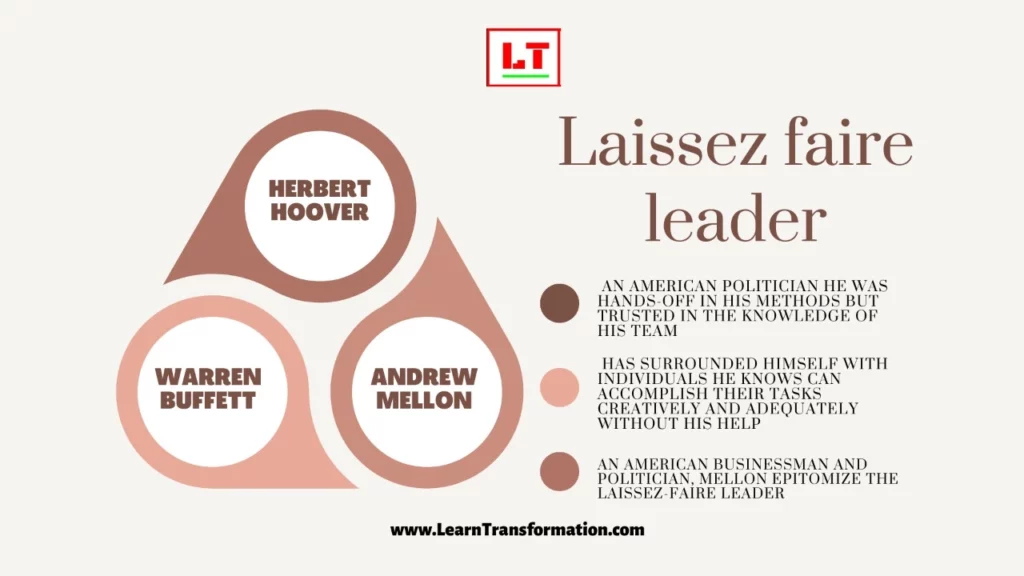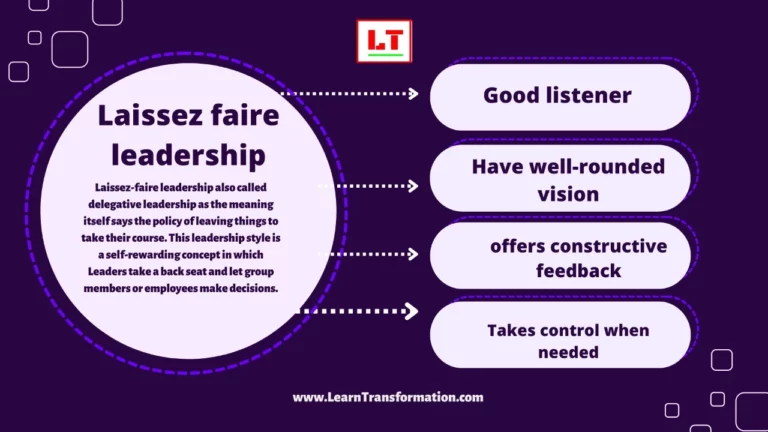Pick out associates whose behavior is better than yours and you’ll drift in that direction.
Warren Buffett
Laissez-faire leadership, also known as the “hands-free approach,” is a leadership style that emphasizes autonomy and minimal administrative intervention. With this approach, leaders give team members the freedom to make decisions, set their own goals, and determine the best course of action to achieve them.
The term “laissefaire” is of French origin and means “let them do as they please”. Similarly, in laissez-faire leadership, the leader steps back and gives team members ownership of their work. Provide a supportive environment, resources, and guidance as needed, but refrain from micro-managing or over-managing.
One of his key principles of laissez-faire leadership is to enable individuals to leverage their skills, knowledge, and expertise to drive their own success. This style works especially well when working with a team of highly skilled and self-motivated individuals who thrive in an environment that encourages creativity and independent thinking.
However, it is important to note that laissez-faire leadership is not without challenges either. Without clear expectations, some team members may find it difficult to define their roles and goals, which can lead to confusion and decreased productivity. Additionally, without a strong leadership presence, accountability and coordination can become even more difficult.
This blog explores its characteristics, benefits, and potential challenges. Additionally, it provides valuable tips for administrators who want to effectively implement this management style. Understanding and harnessing the power of laissez-faire leadership can help teams reach their full potential, fostering innovation, motivation, and personal growth.
- What is Laissez Faire Leadership?
- Who is a Laissez Faire Leader?
- What are Examples of a Laissez-Faire Leader?
- What is Laissez Faire Leadership Style?
- What is Laissez Faire Leadership Theory?
- Difference b/w Laissez Faire and Transformational Leadership
- What are 5 Laissez Faire Leader Qualities?
- What are Laissez Faire Leadership?
- 5 best Leadership Quotes
- 5 Advantages & Disadvantages of Laissez Faire Leadership
What is Laissez Faire Leadership?
Laissez faire leadership also called delegative leadership as the meaning itself says the policy of leaving things to take their course. This leadership style is a self-rewarding concept in which Leaders take a back seat and let group members or employees make decisions.
Who is a Laissez Faire Leader?
A laissez faire leader continues to give the resources and tools that his teams require to succeed while taking hands-off and allowing the employees to work towards the shared goal and leadership development.
Check it out – Transformational Leader Should Avoid these 10 Habits to be Successful
Leader’s Tip:
Strike a balance: Define expectations and objectives whilst offering support, so that autonomy is balanced with guidance.
What are Examples of a Laissez-Faire Leader?
Examples of Great Leaders who followed Laissez Faire style of Leadership:
- Herbert Hoover – An American politician He was hands-off in his methods but trusted in the knowledge of his team, as he had no experience in elected office and relied only on his engineering expertise.
- Warren Buffett- has surrounded himself with individuals he knows can accomplish their tasks creatively and adequately without his help and has only intervened when necessary to remedy any adverse situation, not to mention allowing mistakes to occur so that his staff can learn from them.
- Andrew Mellon- an American businessman and politician, Mellon epitomize the laissez-faire leader, in addition to believing in hiring skilled and knowledgeable people to operate businesses, he also rejected government intrusion in the form of tariffs and other laws.
- Martin Van Buren– who served as 8th president of the united states. In his leadership style, he encouraged his followers to use their skills to assist in the creation of a democratic organizational structure.

What is Laissez Faire Leadership Style?
The Laissez-Faire or Free-Rein leadership style is one in which the leader offers his subordinates complete autonomy to operate on their own. The leader defines the goals, policies, programmes, and action limitations first, then delegates the rest of the process to the subordinates to accomplish independently.
What is Laissez Faire Leadership Theory?
It is a theory of leadership in which leaders allow their subordinates to execute tasks in the way they see fit, rather than imposing rigorous norms or processes. Building a good team and then staying out of the way is the secret to success for a laissez-faire leader.
Difference b/w Laissez Faire and Transformational Leadership
- In transformational leadership, the leadership role is to give all-time guidance to the followers, whereas in laissez-faire leadership, one-time guidance is given by the leader, and then the task is in the hands of the followers.
- Transformational leadership is directive, whereas laissez faire leadership is non-directive.
- Leaders act as role models in transformational leadership but may not act as role models in laissez faire leadership.
Check it out – Unlocking 10 Benefits of Leadership Development to Increase Organization Productivity By 200%
What are 5 Laissez Faire Leader Qualities?
Here are Five Leadership Skills:
- Good listener
- Have well-rounded vision
- Place trust in others
- offers constructive feedback
- Takes control when needed
What are Laissez Faire Leadership?
Here are some examples :
Panama Canal
Construction of the Panama Canal is one example of it. The Panama Canal was one of the most innovative constructions of the early twentieth century, beginning in 1904. Also, Theodore Roosevelt, the president of the United States at the time, was in charge of the project.
The Panama Canal’s construction in 1914 was an engineering marvel to be proud of because it was completed successfully despite being plagued by accidents and topographical challenges. The Panama Canal, on the other hand, would never have been built if President Roosevelt had not been willing to delegate authority and decision-making to those with the appropriate talents and expertise.
Transcontinental Railroad
Because no single person was responsible for the construction of this railway system, it serves as an excellent example of this style of leadership in action, combining presidential directives, congressional cooperation, and private enterprise to lay thousands of miles of track throughout the US territory.
Interstate Highway System
After understanding the importance of the transportation and automobile sectors to the country’s future, US President Dwight D. Eisenhower led the development of this state-of-the-art highway system. Again, Eisenhower’s hands-off style, delegating responsibility to contractors, civil engineers, and specialist labour, would not have allowed this to happen.
Hoover Dam
Under President Calvin Coolidge’s administration, Secretary of Commerce Herbert Hoover spearheaded the project, which was finished under President Franklin D. Roosevelt the following decade. Roosevelt could not have finished these and many other projects without delegation of authority, which is a term that is rarely linked with laissez-faire leadership.
Read Also: 77 LGBTQ+ Pride Gift Ideas for Pride month
Leader’s Tip:
Fostering trust: Ensure the confidence of your team, avoid micromanaging and provide feedback in order to maintain a sense of autonomy and accountability.
5 best Leadership Quotes
Here are five Leadership lessons:
- “If your actions inspire others to dream more, learn more, do more and become more, you are a leader.”
-John Quincy Adams - “Innovation distinguishes between a leader and a follower.”
-Steve Jobs, Apple co-founder - “Leadership and learning are indispensable to each other.”
-John F. Kennedy - “A good objective of leadership is to help those who are doing poorly to do well and to help those who are doing well to do even better.”
-Jim Rohn - “The single biggest way to impact an organization is to focus on leadership development. There is almost no limit to the potential of an organization that recruits good people, raises them up as leaders and continually develops them.”
-John Maxwell
5 Advantages & Disadvantages of Laissez Faire Leadership
Advantages are:
- It enhances Personal Growth, learning, development and Motivation.
- Retards the decision-making time.
- Enables team members to develop their leadership abilities and helps them lead in management.
- Encourages team members to develop their leadership abilities.
- Increases individual satisfaction.
Disadvantages are:
- Creates confusion
- Challenging to adjust to changing circumstances.
- Low Accountability
- The leader might make a mistake in choosing suitable employees.
- Leaders, hands-off nature may result in lack of Motivation.
FAQS:
What is laissez-faire leadership?
Laissez-faire leadership is a style of leadership in which the leader adopts a hands-off stance and permits subordinates or team members to take initiative and complete tasks with little direction or oversight. In this leadership style, the boss gives employees little to no advice, enabling them to work independently and freely.
What are the key characteristics of laissez-faire leadership?
Laissez-faire leadership is characterised by minimum involvement on the part of the leader, a high level of employee autonomy, and an emphasis on personal autonomy and self-direction. it typically don’t give explicit directions or actively monitor progress, but they do offer resources and support when necessary.
What are the potential challenges of laissez-faire leadership?
Laissez-faire leadership can be useful in some circumstances, but it also has drawbacks. Lack of direction or clarity is one potential downside, which can cause confusion or inefficiency if team members are unsure of their duties or goals. In some circumstances, people can need more direction or structure to work at their best. Without adequate supervision, there is also a risk of less accountability and a chance of lower output or job quality.
When is laissez-faire leadership most appropriate?
When people are highly trained, experienced, and driven to take ownership of their job, laissez-faire leadership is most suited. When team members are capable of working autonomously without continual supervision and have a strong feeling of responsibility, it works effectively. Laissez-faire leadership also encourages creativity and innovation since it gives people the freedom to experiment with fresh concepts and methods. However, it might not be appropriate in circumstances requiring a clear direction and structure, such high-stakes or time-sensitive projects.
Key Takeaways:
- Laissez-faire leadership promotes autonomy and freedom in decision-making.
- Clear expectations and support are essential for successful laissez-faire leadership.
- Trust, open communication, and accountability are essential elements of laissez-faire leadership.

